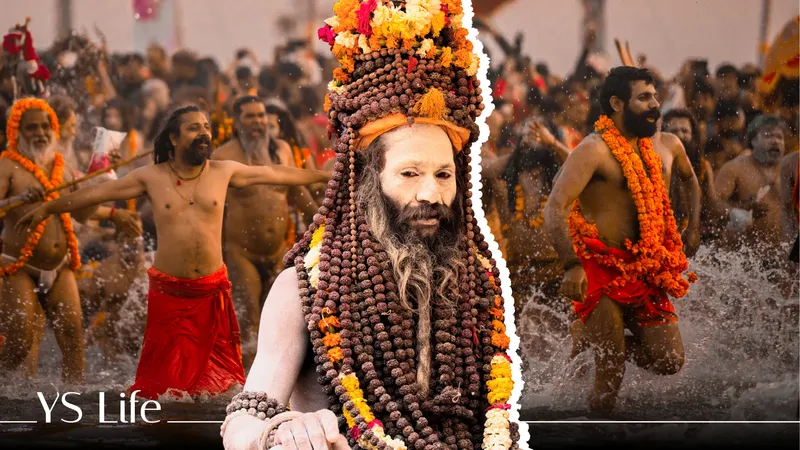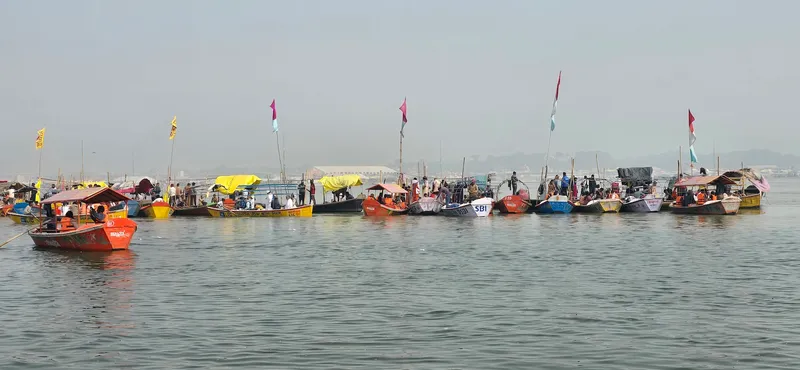Maha Kumbh 2025: A spiritual gathering of sadhus, stories, and devotion
In the run-up to the Maha Kumbh 2025, YS Life visited Prayagraj to witness the once-in-a-lifetime event that has occurred after 144 years.
I've visited the dusty city of Prayagraj (formerly Allahabad) in the northern state of Uttar Pradesh on umpteen occasions. Besides its street food, everything else felt dull and uninspiring.
This time was different.
When I landed in Prayagraj for a preview of Maha Kumbh 2025, it felt like the city was vibrating at a higher frequency.

From massive murals to street art, rhythmic chanting of mantras to a glimpse of saffron-clad sadhus—the atmosphere was vibrant with celebration.
The evenings were all about peshwai or processions. Brightly lit tableaus (jhankis) from different akharas (spiritual institutions that preserve Hindu practices) would surface on the streets, drawing curiosity from passersby.
Often, these had cut-outs of cows peeking out, or playing bhajans in Bollywood tunes.
After all, this momentous occasion had arrived after 144 years. While the Ardh Kumbh happens every six years and the Purna Kumbh after 12 years, the Maha Kumbh commemorates the rare celestial alignment of the Sun, Moon, and Jupiter, creating an auspicious time for taking a dip in the holy river.
No wonder, an estimated 45 crore visitors are expected to visit Prayagraj between January 13 to February 26, 2025. Indian Railways has announced 98 special trains that will make 3,300 trips during the event to transport visitors, besides regular trains.
A once-in-a-lifetime gathering
The Kumbh Mela is considered the largest religious gathering of people on earth. According to the Hindu legend of Samudra Manthan, the gods and demons churned the cosmic ocean to extract amrit, the nectar of immortality. During this celestial battle, drops of the elixir fell in four cities—Haridwar, Ujjain, Nashik, and Prayagraj, where the festival is held every three years in rotation.
The Triveni Sangam in Prayagraj is the spiritual heart of the Maha Kumbh. After all, it is where the clear waters of the Ganga, greenish waters of the Yamuna, and the mythical Saraswati rivers converge.

According to mythology, a dip in these holy waters, particularly on days of the Shahi Snan (ritual bath), absolves devotees of all sins and leads to moksha or salvation. These dates are determined by astrology based on the alignment of the planets or constellations.
This is one of the biggest attractions for people to visit the Maha Kumbh. Before reaching Prayagraj, I was sceptical about taking a dip in the sangam. From the biting cold to concerns about hygiene, there were several reasons dissuading me.
My apprehensions evaporated as the chants of ‘Har Har Gange’ grew louder. The next moment, I found myself in the waters, drenched in happiness.
While it was icy cold, the sanctity of the experience left me warm.
Tales of perseverance
The Maha Kumbh is also about the tales of penance and perseverance practised by sadhus. A total of 13 akharas, including Juna, Niranjan, Nirmohi, Nirvani and Nirmal, among others, are participating in the mega gathering this year.
While there's much to learn from different groups of ascetics, the holy ash-covered Naga sadhus–bare bodied with matted dreadlocks, embody the ultimate expression of spiritual renunciation. Their appearance often invokes curiosity, which leads the devotees and visitors to photograph them. While it is allowed, people are generally instructed to avoid mouthing anything offensive or being too close to them.

This behaviour may be perceived as rude or aloof by many (but they aren't). Instead, their spiritual learning and physical penance will leave you awestruck.
While my fellow travellers and I were shivering in the cold weather, these sadhus were comfortable in their skin (no pun intended).
This was only a sneak peek.
As we walked through the bylanes of Juna akhara, I witnessed scenes that would always stay with me. A sadhu, colloquially known as Khadeshwar baba, hasn't attempted a sitting or sleeping position in several years. Another had one of his hands tied as a form of penance through hatha yoga.
Others were either immersed in meditation, engaged in performing a havan, or seen holding their damrus or tridents.
All in all, it was a unique experience to see these sadhus up, close, and personal.
A luxurious stay
To accommodate the massive crowd of devotees, over 1,50,000 tents have already been set up. For my visit, I opted for a Luxury Tent in the 17-acre jüSTa Shivir Jhusi, set on the banks of the Ganga.

jüSTa Shivir Jhusi
Who would have thought glamping would be possible during the Kumbh? My accommodation was comfortable and spread across an expansive 900 square feet. The tastefully decorated tent had a bedroom with a four-poster bed, living space with plush sofas and a study desk, a vanity area and an attached bathroom with 24-hour running hot water.
With 117 tents on offer in the campsite in Jhusi village, one could also opt for other categories like Premium Tents or the Family Suite Tent.
There’s a restaurant within the premises that offers vegetarian food. Besides Indian dishes, one can also enjoy Chinese and Italian cuisine.
Guests can also request services like guided yoga and meditation, boat cruises along the sacred rivers, and walking tours of the akharas.
An event like this may be overwhelming due to the madding crowd. But if you want to experience the convergence of different cultures and practices, it is worth a shot.
You may believe in religion or not—but the energy in Prayagraj during the Maha Kumbh is infectious, so go with an open mind and heart. If nothing else, it will leave you with an important lesson or two!
Edited by Megha Reddy







